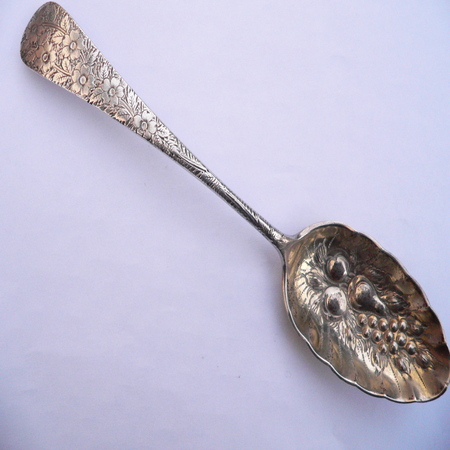Can anyone give me any information on this berry spoon, was the berry part of the original design or has it been added later?

You are right to be suspicious, as berry spoons are often Georgian table spoons, later chased in the Victorian period.
In English silver, its easy to determine the truth. If the hallmarks are Georgian, it was later chased. If the hallmarks are Victorian it was always a berry spoon.
In your case, you need to determine the age. As you say the piece is Gorham silver, I assume that the piece carries some hallmarks. Can you post images of the marks??
Once we know the age, we can decide whether the chasing is original. Pre about 1835 would suggest the piece is later chased. Post 1835, its probably original.
Regards / Jonathan
I have done my best with this picture of the Gorham mark… It’s ironic that I post a question on American silver on an American forum and get a reply form an Englishman! still who cares as long as he’s an expert!
![rsz_1AAA1P1010534[1].jpg](https://www.silver-collector.com/uploads/db2678/original/1X/71dab5c06cc0aee48df920e179478cf3bc565fcb.jpeg)
I just found this article on Gorham silver on wikipedia…
en.wikipedia.org/wiki/Gorham_Man … ng_Company
This shows that Gorham was founded in 1830 and as such I think we can be confident that the chasing is original.
Furthermore, according to this…
925-1000.com/Gorham_Date_Code.html
the marks seem to suggest the piece is late 19th century. However, I’m not sure that I’ve read that chart correctly.
Hope that helps.
P.S. silver-collector was started by my brother and I in London, UK!
Many thanks for this information. I am also a watch collector and depend a lot on Time Zone which attracts many avid experts from all over the world. I think that this site has the makings of a similar such authoratative fount of information for silver collectors. it is in its early stages and needs more contributors, but, hopefully, these will come. Being born in the Blackcountry of England, I have a great affection for Birmingham and its wonderful heritage in jewellery manufacture. I have done some silversmithing courses in Hereford and now have a workshop at home where I undertake a little modest work of my own. it was a thrill for me to take work to the Birmingham Assay office, the busiest assay office in the world, for hallmarking.
I just checked out the Time Zone site! Very nice!
Thanks for the enthusiastic response and welcome to the team!
Regards / Jonathan
So - what about my Gorham spoon. I make it last quarter of 19th centuary and would gusess that it has been “berried” with one of the press tools in use for convertying Geeorgian spoons at the time. Does anyone else have an opinion?
As you say, it appears that the spoon has marks for around the last quarter of the 19th century.
If this is when the spoon was produced it is very likely that it was always a berry spoon.
The question is… Could Gorham have bonked an older georgian spoon and added their own marks at this time? It seems unlikely to me that a large manufacturing firm would do this. However, I am not a specialist of American silver.
I think that there is no doubt that this a a Gorham made spoon, bearing their marks and no British marks. it could have then have had the beries pressed in in this country using tooling in use at the time converting Georgian spoons to berry spoons.
I have an example of a Georgian spoon that has been converted to a berry spoon.
I was wondering when this happened was it the work of ordinary people pursuing a hobby or actual silversmiths? Did some artists sign their work? My example features a fruit theme. Are some themes more desirable than others? Did the gilding use the dangerous Mercury method?
Converting plain Georgian spoons to berry spoons began in the mid-nineteenth century. The bowls were reshaped in a die and sometimes the stems were also decorated with engraving.
A HUGE amount of spoons were converted in this way. It was very much a professional practice.
Regards // Jonathan
[color=cyan]Thanks again Jonathan. You are really a fountain of knowledge. I really enjoy learning more about silver. I have actually been seeing quite a few of these Georgian-Victorian spoons and they seem popular so I decided to keep mine instead of trade it for a bowl or some other piece of silver.
So, are you saying all berry spoons, be they genuine or modified, are Victorian? Were berry spoons not popular during the 18th to early 19th centuries?
According to Pickford’s ‘Silver Flatware’ (which is the definitive resource on British flatware), the practice of converting berry spoons began in the mid-nineteenth century (pg 70). He also says that decorative spoons for serving fruit were produced in the 19th and 20th century (pg 182).
This seems to suggest that there may have been berry spoons produced in the early 19th century, even before the process of converting spoons began. That said, it is my believe that fruit spoons didn’t reach popularity until the mid-nineteenth century and it is generally excepted that the vast majority of Georgian marked berry spoons were converted at a later date.
Regards // Jonathan
I’ve never been drawn to berry spoons and hadn’t really thought much about them, and what you say makes perfectly good sense. Berry spoons have all the trappings and appearances of Victorian kitsch. Even the name “berry spoon” fits their regimen of familiarising inanimate objects with cosy monikers.